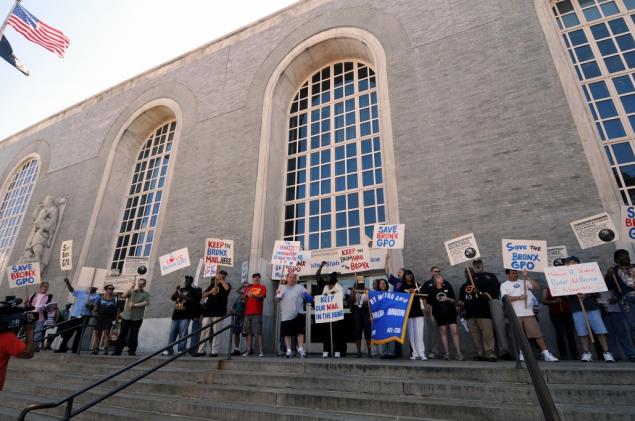 An article published in the Washington Post earlier this week highlights the dramatic decline of the United States Postal Service and the financial difficulty that it is facing today. Since the passing of the Postal Accountability and Enhancement Act (PAEA) in 2006, the postal service has started running massive deficits has been forced to lay off tens of thousands of workers. To remedy this financial mess, the USPS has increasingly started to sell historic Post Office buildings, often centrally located on valuable tracts of land, to raise money. An article published in the Washington Post earlier this week highlights the dramatic decline of the United States Postal Service and the financial difficulty that it is facing today. Since the passing of the Postal Accountability and Enhancement Act (PAEA) in 2006, the postal service has started running massive deficits has been forced to lay off tens of thousands of workers. To remedy this financial mess, the USPS has increasingly started to sell historic Post Office buildings, often centrally located on valuable tracts of land, to raise money.
Read more »
On Thursday, the National League of Cities released The 10 Critical Imperatives Facing Cities in 2014, its annual report highlighting ten of the most pressing issues facing cities across the United States. Partners board member and incoming NLC President, Salt Lake City Mayor Ralph Becker explained during the report's unveiling, "This is not a wish list just of cities. This is a wish list of the people who live in America. That’s 80 percent of the population of America that’s being represented through us."
The ten items on the list were:
- Fragile Fiscal Health
- Deteriorating Transportation Infrastructure
- The Shrinking Middle Class
- Inadequate Access to Higher Education
- The Need for Affordable Housing
- A Less-Than-Welcoming Return for Veterans
- Gang Violence
- A Broken Immigration System
- Climate Change and Extreme Weather
- Lack of Public Trust
Click here to read the full report from NLC, which includes an overview of initiatives being taken by cities in their own efforts to tackle these ten challenges and create more livable communities for their residents.
Read more »
Terms:Community Building, Community Development, Downtown Development, Economic Development, Education, Environment, Health & Wellness, Housing, Immigration, Neighborhood Revitalization, Other Reports/Publications, Placemaking, Public-Private Partnerships, Transportation, Urban
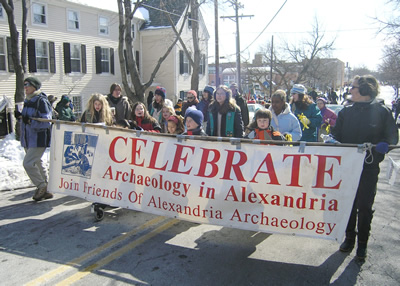
During the 1960s, Washington, DC and its surrounding communities experienced an urban renewal that saw a rebuilding of infrastructure and consequently required the destruction of a number of older buildings in the area. In Alexandria, an independent city a short distance from DC, the destruction of the old buildings uncovered an abundance of historical artifacts that shed light on the history of the area. Realizing that there was a plethora of previously undiscovered, culturally-important artifacts right beneath their feet, the city’s leadership created the Office of Historic Alexandria to try to cultivate and make sense of this new information.
Read more »
Terms:Community Building, Community Engagement, Creative Economy, Cultural Institutions, Heritage, Historic Preservation, IFC Best Practice, Museums, Public-Private Partnerships, Tourism, Washington, DC
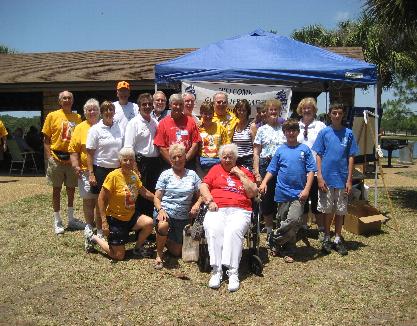
Across America state and local governments are figuring out how to deal with aging populations as modern medicine and technology are starting to ensure that people, on average, live longer. According to the 2012 U.S. Census, Florida possesses one of the oldest populations in the United States, as more than 18% of Florida residents are over the age of 65, almost 5 percentage points higher than the national average. To help their aging population remain healthy and lead productive lives, local governments and community organizations are finding creative ways to encourage active lifestyles for older adults. The Good Life Games of Pinellas County Florida has proven to be a very successful way to encourage fitness among older residents of the county, and their model is being replicated throughout the country.
Read more »

Last month the nonprofit group America Achieves released a report titled Geek Cities: How Smarter Use of Data and Evidence Can Improve Lives through their Results for America initiative with support from Bloomberg Philanthropies. The report dissects how leaders in six major cities throughout the United States (and one initiative in London) are using data and technology to improve the lives of their residents. Rapidly improving technology and the digitalization of information has made mass data collection easier than ever, and cities are using this data to find effective programs and measures to combat social, economic, and physical challenges that many face today.
Read more »
Cincinnati Magazine published an article on October 30th outlining the recent history of Wilmington, Ohio. Wilmington, like so many small towns across the country, suffered immensely during the recession. In 2008 the town’s largest employer, DHL Shipping, announced that it planned to end its partnership with Airborne Express, who operated the Wilmington Air Park, and find another U.S. partner. The loss of nearly 10,000 jobs meant the city’s unemployment rate skyrocketed from 3 percent in 2007 to 19 percent by 2010. Wilmington quickly became the face of the recession, and large scale impact the economic downturn had received media attention from many major news outlets, including the New York Times and 60 minutes.
Read more »
Lyz Crane draws on the work of practitioners and researchers to characterize the field of arts-based community development in which arts and culture can help achieve place based change related to the physical, social, and economic dimensions of place. This paper examines the premise that the existence of arts is considered a powerful end in itself, Crane then outlines the variety of ways that the actors and activities involved in arts and community development work can relate to and interact with each other to create sustainable communities. Looking at the cultural ecology of place, creative economy development focuses on fostering local creative businesses and supporting creative workers both in the arts and in supporting industries while cultural development may focus on preserving cultural assets—traditions, language, stories—or on building on them to create stronger, more connected communities. There is also a complex community development ecosystem of organizations, interests, and tools. Stakeholders may involve arts in their agendas, create arts programming, provide or develop arts spaces, employ artists, and/or partner with arts organizations. Indeed, both the arts and community development are part of the same ecosystem and all of these 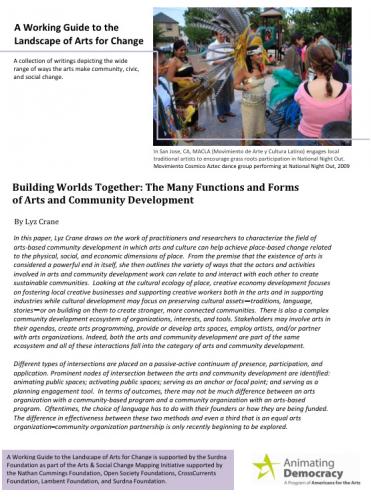 interactions fall into the category of arts and community development. interactions fall into the category of arts and community development.
Crane places different types of intersections on a passive-active continuum of presence, participation, and application. Prominent nodes of intersection between the arts and community development are identified: animating public spaces; activating public spaces; serving as an anchor or focal point; and serving as a planning engagement tool. Crane points out that, in terms of outcomes, there may not be much difference between an arts organization with a community-based program and a community organization with an arts-based program. Oftentimes, the choice of language has to do with their founders or how they are being funded. The difference in effectiveness between these two methods and even a third that is an equal arts organization–community organization partnership is only recently beginning to be explored.
Click here to download the whole document.
Read more »
Terms:2012, Arts & Culture, Business, CBC Report/Publication, Community Building, Community Development, Community Engagement, Creative Economy, Cultural Institutions, Featured, Other Reports/Publications, Placemaking, Public Art, Public-Private Partnerships
Recess for seniors may sound unusual, but it is just one of many volunteer roles that the Rochester School District’s Office of Extended School Programs has developed to increase community involvement in its elementary schools. The Rochester School Department defines as its goal the enhanced achievement and academic success of students who participate in extended-school programs. Volunteers play a key role in support of these programs. The Office organizes enrichment programs by sharing resources, creating partnerships with businesses and community organizations, and involving parents.
These programs have proven to be a boon to both students and volunteers, many of whom are older adults. Intergenerational activities benefit senior volunteers, who take pleasure in giving back to their communities and participating in a structured social environment. They often exult in the joy of working with children.
Read more »
 photo credit SCOPE photo credit SCOPE
SCOPE’s (Sarasota County Openly Plans for Excellence) mission is to connect and inspire citizens to create a better community. A private nonprofit, SCOPE is a convener, catalyst and facilitator, partnering with residents to generate collective action around issues affecting quality of life. It is fitting that Sarasota County, as the oldest in the nation and with 30 percent of its residents over 65, focuses considerable attention on aging. Founded in 2001, SCOPE collaborates with Sarasota County residents, elected officials, and community organizations to support broad-based undertakings led by citizens, to solve a variety of community concerns. Initiatives have addressed the environment, transportation, family violence, community change, and the needs of aging residents, to name just a few. All SCOPE activities address issues that strongly influence the quality of life in Sarasota County.
With Sarasota County’s large older adult population, it is not surprising that SCOPE’s perspective on aging is both positive and constructive. It views Sarasota County’s older adults as assets to and active participants in the community. In 2005, to examine the consequences of aging, the opportunities and challenges, SCOPE launched the initiative Aging: The Possibilities. Over 900 residents participated in many discussions, and presentations by experts covered a range of issues relevant to community planning for aging residents—and on their great capacity for enhancing the quality of life in Sarasota County.
Read more »
Terms:2012, Aging, Aging in Place, AIP Best Practice, Chamber of Commerce, City Leaders Institute on Aging in Place, Community Building, Housing, Philanthropy/Community Foundation, Public-Private Partnerships, Transportation
 photo credit Phoenix New Times photo credit Phoenix New Times
The Arizona Science Center has long engaged adult volunteers age 50+ as docents, and in
other conventional volunteer roles, but only recently the Center began to tap volunteers’ science and technology skills to enhance its programs. Jan Stonebraker, the Science Center volunteer coordinator of four years, entered the position as the Center launched a large travelling exhibition titled Body Worlds 3, an exploration of biology and anatomy.
Stonebraker identified knowledgeable volunteers to help staff the exhibition. At around the same time, the Virginia G. Piper Charitable Trust funded a leadership grant program, through the National Council on Aging (NCOA), to engage adult volunteers age 50+ in leadership roles. The Science Center development staff and Stonebraker designed a program that would qualify for a grant. Stonebraker found that many volunteers were retired mechanical and electrical engineers, information technology specialists, and science teachers who wanted to help the Center. It made eminent sense to use their skills to enhance educational programs.
Read more »
Terms:2012, Aging, Aging in Place, AIP Best Practice, Arizona, City Leaders Institute on Aging in Place, Community Engagement, Education, Intergenerational, Jobs, Life-Long Learning, Museums, Public-Private Partnerships
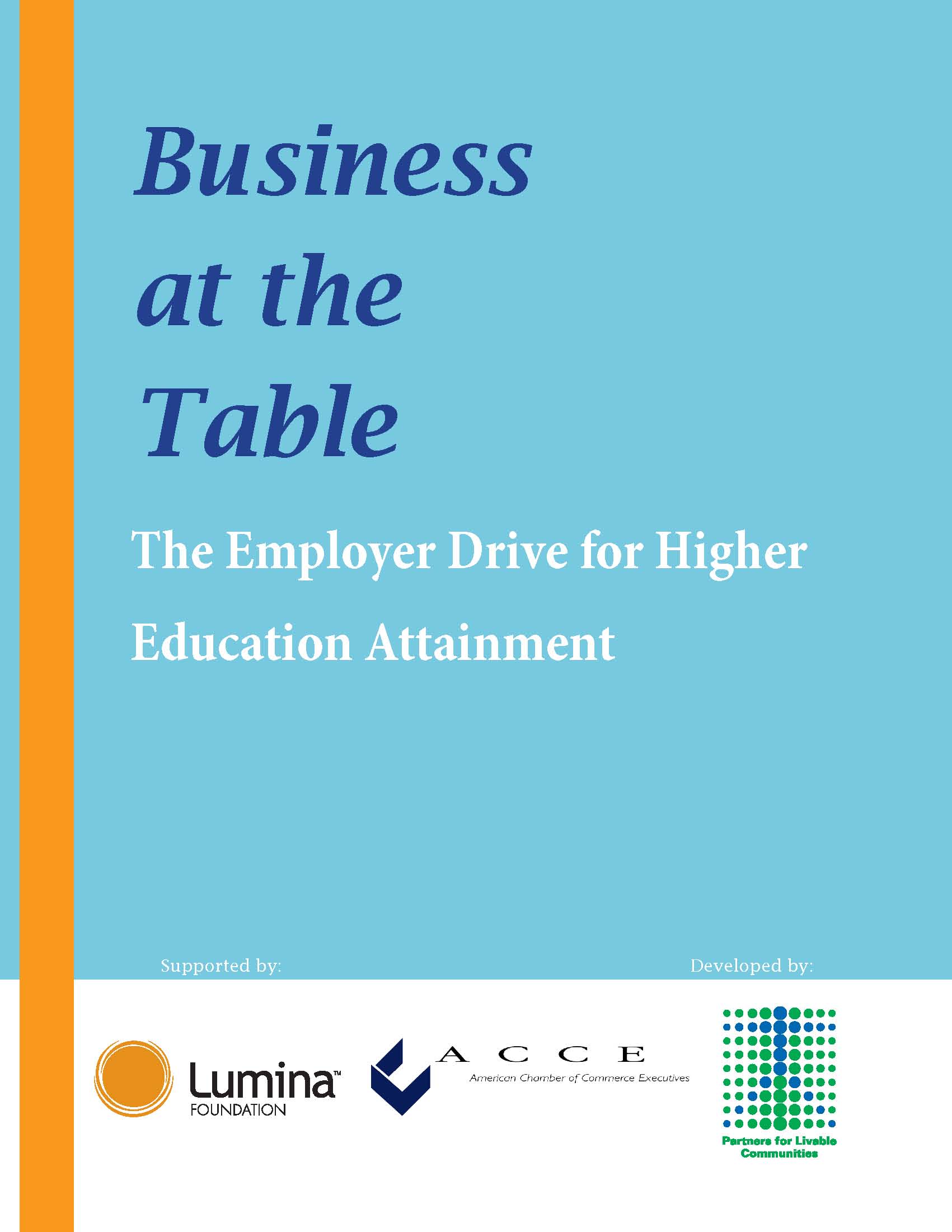 Partners for Livable Communities (Partners), in partnership with the American Chamber of Commerce Executives (ACCE) and with funding from Lumina Foundation, releases Business at the Table: The Employer Drive for Higher Education Attainment. This collection of case studies was created during the Business at the Table initiative to develop strategies for improving U.S. higher education attainment (degrees and credentials) through chamber of commerce and business involvement. Partners for Livable Communities (Partners), in partnership with the American Chamber of Commerce Executives (ACCE) and with funding from Lumina Foundation, releases Business at the Table: The Employer Drive for Higher Education Attainment. This collection of case studies was created during the Business at the Table initiative to develop strategies for improving U.S. higher education attainment (degrees and credentials) through chamber of commerce and business involvement.
This compendium of case studies provides business and chamber leaders the perspective to further Lumina’s Goal 2025: to increase the proportion of Americans with high-quality degrees and credentials to 60 percent by the year 2025. Included are programs led by chambers of commerce, two-year and four-year colleges and universities, and national and local higher education achievement programs. Interviews were conducted with the CEO or director of each program, providing personal accounts of trials and victories on the road to success. Case studies explore the history of the program or organization, key players, geographic context, specific place-based economic challenges that were overcome, and the short and long-term goals that have been achieved.
Read more »
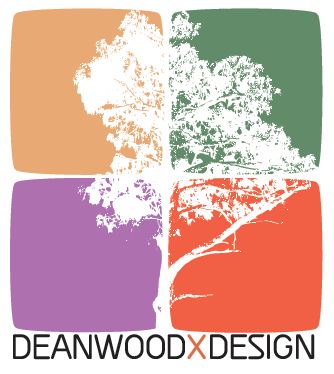 The D.C. Office of Planning (OP) has awarded a $75,000 “ArtPlace Arts and Culture Temporium” grant to Partners for Livable Communities (Partners) to develop and manage temporiums in underutilized spaces in the Deanwood neighborhood, one of the District’s earliest African American communities. The D.C. Office of Planning (OP) has awarded a $75,000 “ArtPlace Arts and Culture Temporium” grant to Partners for Livable Communities (Partners) to develop and manage temporiums in underutilized spaces in the Deanwood neighborhood, one of the District’s earliest African American communities.
Under this grant, Partners will develop and manage DeanwoodxDesign, a project that showcases the rich arts, cultural, historical, and green space assets of Deanwood and Ward 7 through a community-wide, intergenerational, and collaborative effort. This project engages artists and a diverse network of Deanwood institutions and stakeholders to cultivate community pride, showcase and create great art, and invigorate the creative economy.
Read more »
Terms:Announcements, Arts & Culture, CBC Best Practice, CBC Event, Community Building, Community Engagement, Creative Economy, Culture Builds Communities, Design, Multicultural, Neighborhood Revitalization, Placemaking, Public Art, Public-Private Partnerships, Urban, Washington, DC
Partners’ board member Sam Williams, President of the Metro Atlanta Chamber, carried the banner for business leadership in helping to solve urban problems during remarks last month to the TEDxAtlanta conference. Calling for business leaders to fulfill roles as “urban statesmen,” Williams articulated a vision shared by Partners in which business leaders and elected officials can work together as members of a team to find creative and innovative solutions to urban problems. Service on Partners’ board is just one way in which Mr. Williams works daily to translate this vision into reality.
Read more »
Two major programs and partnerships in the Chattanooga Region were each awarded a "JumpStart the Conversation" grant in September 2009. The winning projects exemplify the use of innovative ideas focused on creating livable communities for all ages and the theme of Building Partnerships. Click here to view the grants below.
As part of the national movement to promote the “Aging in Place” Initiative, which is aimed at helping older Americans remain in their communities, the Chattanooga Metro Area has been selected to host one in a series of national workshops to consider creating livable communities for all ages. These workshops are being sponsored by MetLife Foundation, Partners for Livable Communities (Partners), and the National Association of Area Agencies on Aging (n4a).
The Chattanooga workshop, titled Building Partnerships: Creating a Livable Community for All Ages (Choose Chattanooga: Come Live with Us), was held on 30, 2009. The event was be co-hosted by the Southeast Tennessee Area Agency on Aging and Disability, Choose Chattanooga, the City of Chattanooga, Hamilton County, Morning Pointe, the Greater Chattanooga Chamber of Commerce, and the Tennessee Multicultural Chamber of Commerce.
Steve Witt, Director of the Southeast Tennessee Area Agency on Aging and Disability, stated that “Community leaders have already seen enormous goals met that contribute to Chattanooga being a place that appeals to people of all ages. It is exciting to be part of an initiative that can help us continue to move forward.”
Chattanooga Jumpstart Grants
- Friends of Outdoor Chattanooga and Active Living and Transportation Network
To explore new partnerships within the senior community and be able to expand programming to better reach the older adult demographic and promote active transportation through bicycling. Two workshops will be held for active seniors and related agencies to develop opportunities to promote the safe use of bicycling for transportation and recreation, especially in the urban core area.
- Get Online Event: A community-wide, multi-generational interactive opportunity
The following organizations will be working together for the first time ever through a brand new partnership formed to improve community-wide communication and civic involvement by teaching basic, practical computer skills at the “Get OnLine” Event. This “learning event” will be a community-wide, multi-generational interactive opportunity. Continued partner efforts will help members adapt to what older adult learners want and need to know to thrive in a livable community, as well as how to engage additional partners to further collaborative efforts.
- "Choose Chattanooga" and The Chattanooga Health and Performance Institute
To coordinate marketing, promotion and continued collaboration among partners for the “Get OnLine” event which will improve communication between service providers and the citizens they serve, with a special emphasis on the older adult citizens.
- Friends of the Library
To host several computer technology training events at area branches using existing computers with internet access and to educate technically illiterate and disenfranchised older adult members of the community.
- Senior Neighbors
To host several computer technology training events at area senior centers using existing computers with internet access. Senior Neighbors is the area’s largest outreach organization reaching senior citizens in often underserved locations across Hamilton County. Recently added new computers and internet access, but instruction resources are limited and services are underutilized. Through partnership support — Senior Neighbors’ will reach a larger portion of the older demographic.
- Alton Park Development Corporation
To host older adult computer classes at Alton Park area community centers, one of Chattanooga’s most economically distressed and impoverished areas.
- Southeast Development Foundation
To coordinate and establish a mature workers job club and provide technology and computer training to members of that community as more people in this age group struggle to gain the latest job skills to find second careers in their later years.
- City of Chattanooga Department of Education, Arts & Culture
To provide computer training to senior citizens through workshops, instruction and access to computers and internet at the Senior Activity Center, located at Eastgate Town Center. Due to underfunding there is currently a waiting list of more than 300 Senior Citizens waiting to learn basic computer skills. They are currently not being served at all because there are no instructors to meet the demand. Grant monies will fund instruction otherwise unavailable.
- City of Chattanooga Department of Parks and Recreation
To provide computer training to disenfranchised citizens through workshops, instruction and access to computers and internet at the Brainerd Recreation Center. Computers and internet access was recently installed at the rec centers—however these new services are not utilized because of a lack of education and available training. This event will allow them to reach the older adult population served by this rec-center.
- Chattanooga State Technical Community College
To host classes at its campus and provide school trained instructors and educational materials. Classes will be available to older adult members of the public who would otherwise be unable to afford such instruction.
- Association of Visual Arts
To serve as a centrally located learning facility and resource center for digital content development and creative self expression and to offer technology and photography training classes at the Chattanooga media center to older adults who would be otherwise unable to afford such instruction. AVA will target lifelong learners who seek customized training instruction for their careers or personal development.
Read more »
Entrepreneurial Livable Community Award
For the community’s entrepreneurial spirit in its transformation to become a model for sustainable development and prosperity today.
Read more »
Entrepreneurial American Leadership Award
For his 21 years of visionary leadership and devotion to the social and economic wellbeing of Louisville, Kentucky.
Read more »
Partners’ recent forum with the Hirshhorn Museum, “ Building Livable Communities: Creating a Common Agenda,” served as a positive platform to re-announce a new and exciting agenda for architecture, design, and social experimentation: The Hirshhorn Museum and Sculpture Garden’s Bubble Expansion and book store renovation. Attended by Congressional representatives, federal agencies, think tanks, cultural institutions, and community development leaders alike, Director of the Hirshhorn Museum Richard Koshalek discussed the museum’s upcoming plans. The "Bubble,” as it is called for the short-term, is a joint venture of Koshalek and Diller, Scofidio + Renfro, a renowned New York-based design firm, to re-invent the Museum as an intentional classroom and illustrate intersections of public and private space. Additionally, the museum book store will undergo a transition from a common commercial entity to becoming integrated as a part of museum exhibition space, through a renovation and move to the basement of the building. Perhaps this new agenda comes from the idea that we need to adapt spaces to peoples’ readily changing needs. Perhaps this comes from Richard Koshalek’s desire to make the Hirshhorn a world class modern art museum with a daring new exposition. Perhaps this comes from the need to blur public and private space by incorporating The "Bubble” as an almost space-less entity into a negative, or void, of the concrete mass building; and the book store as an experiment in museum exhibit space. Or perhaps this agenda just comes from a need to make the stolid flimsy, the serious fun, and the patron part of the exhibit.
On August 18th, 2010, Partners President Robert McNulty and Partners Trustee and former Florida Secretary of State and Orlando Mayor Glenda Hood hosted a workshop for over 150 attendees of the annual Florida League of Cities conference in Hollywood, Florida. Entitled “Culture Builds Community,” the 3-hour session explored how in these hard times for local governments and public finance, communities can mobilize a team of new players to support cultural and heritage resources as key infrastructure for their citizens, quality of life, and their ability to attract new investment.
Workshop participants learned how to:
Read more »
New York City is famously known for its fast-paced, move-it-or-lose-it way of life. This attitude stems from the large number of young professionals crowding the streets; however life in some parts of the city is slowing down, if only just slightly. New York Academy of Medicine is looking to create 2 age-friendly neighborhoods in New York City. These pilot projects are the result of town hall meetings and focus groups involving thousands of older adults in the area. The Academy listened to concerns people had with walking around their neighborhoods and crossing the street. Ideas for the neighborhoods’ development and amenities have not been finalized, but one would have businesses voluntarily place stickers in their windows signifying their “age-friendliness” while providing extra benches, adequate lighting and menus with large type. The Academy and area businesses recognize these changes are important to attract a demographic with strong economic power. Other street improvements would include increasing crosswalk timing signals to allow elderly more time to cross, more benches on the street and better gutter drainage at intersections. The full article from the New York Times can be accessed here.
Abandoned properties are encountered with rising frequency in these difficult economic times. Most people simply see them as an eyesore or a threat to security. However, there are some organizations, such as Boston Street Lab and Chashama, which have found this situation to be an opportunity to get a little creative.
Read more »
|
|